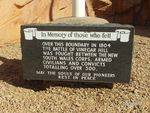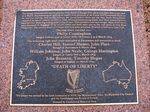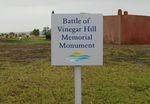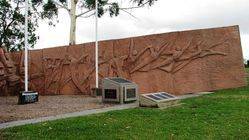
Battle of Vinegar HillPrint Page 
The monument commemorates the Battle of Vinegar Hill in 1804 and also the pioneering spirit of the early non-indigenous settlers. The exact location of the battle is no longer known, but after an inquiry in 1982, it was agreed that a spot in the Castlebrook Lawn Cemetery would be marked by a memorial.
The incident was commemorated from 1983 onwards, and in 1984 Blacktown City Council resolved to conduct a National Design Competition for a permanent memorial. The intention was for the memorial to commemorate the battle, but also to commemorate the pioneering spirit of the early non-indigenous settlers. The judges chose the design submitted by Ivan Polak and Vladimir Sitta for its "bold and prominent sculptured idea, symbolising the foundation and growth of the nation [which] will be appreciated from a distance as well as close-up".
The monument consists of three plaques — one marks the unveiling, one outlines the details of the battle and the third tells the story of the growth of Australia from 1788. In 2004, a plaque was placed at the memorial bearing the names of the men who had fallen in the battle.
The Battle of Vinegar Hill is the name given to the clash between convicts and soldiers on Monday March 5 1804 following on from the Castle Hill uprising the night before. It was the first battle between Europeans on Australian soil.
Convicts, mainly Irish, who were working on the government farm at Toongabbie joined with convicts and settlers in the district. They planned to march to Hawkesbury and team up with other rebels, then on to Parramatta and finally Sydney where they had planned to commandeer a ship home.
News of the uprising spread quickly to Sydney and Governor King dispatched soldiers of the NSW Regiment — later to be known as the infamous "Rum Corps" — who after a forced march faced the rebels at the place later known as Vinegar Hill.
Vinegar Hill was named after a similar hill in Ireland, which was also the scene of battle in the 1798 United Irishmen's uprising. Some of the rebels at Sydney's Vinegar Hill were veterans of the Irish Vinegar Hill.
The convicts' leader, Philip Cunningham, was sent to parley with the commander of the soldiers under a flag of truce, but the soldiers disregarded the flag and fired on the rebels. The result was more of a massacre than a battle, with 11 rebels killed in the hunt that followed and a further nine court-martialed and hanged over the next few days. Cunningham, at first thought to have died during the skirmish, was hanged without trial on the steps of the government store. His grave is located at Windsor, in Sydney's west.
Location
| Address: | Windsor Road, Castlebrook Memorial Park , Rouse Hill, 2153 |
|---|---|
| State: | NSW |
| Area: | AUS |
| GPS Coordinates: | Lat: -33.694025 Long: 150.921604 Note: GPS Coordinates are approximate. |
Details
| Monument Type: | Monument |
|---|---|
| Monument Theme: | Government |
| Sub-Theme: | Dissent |
| Actual Event Start Date: | 04-March-1804 |
| Actual Event End Date: | 05-March-1804 |
| Designer: | I. Polak & V. Sitta |
Dedication
| Actual Monument Dedication Date: | Saturday 5th March, 1988 |
|---|
This plaque commemorates the bicentenary of the Battle of Vinegar Hill, which took place close to this spot of 5 March 1804 following an uprising of mostly Irish prisoners at the Castle Hill Government Farm on the previous evening. The battle, between the poorly-armed rebels and the New South Wales Corps, supported by the armed settlers, resulted in some twenty prisoners being killed, after their leaders had been taken prisoner while negotiating under a flag of truce. Nine prisoners were later hanged. Many of the rebels were sentenced to floggings of up to 500 lashes and some were sent to the colal mines at Coal River (Newcastle). The original Battle of Vinegar Hill took place in County Wexford Ireland on 21 June 1798.
The nine rebels executed were :
Philip Cunningham hanged without trial at Green Hills (Windsor) 5 or 6 March 1804
The remaining eight were court-martialled at Parramatta and sentenced to death
Charles Hill, Samuel Humes, John Place hanged at Parramatta 8 March 1804
William Johnson, John Neal, George Harrington hanged at Castle Hill 9 March 1804
John Brannon, Timothy Hogan hanged at Sydney 10 March 1804
"Death or Liberty"
This plaque was erected by the Irish community in NSW, the Mineworkers` Trust, the Blacktown City Council and the Government and people of Ireland.
Donated by Castlebrook Memorial Park.
Plaque :
Vinegar Hill
On Sunday 6 March 2005 this historic area was officially named Vinegar Hill by the Hon Tony Kelly MLC, Minister for Lands, Minister for Local Government
"It will remain as a permanent reminder of the historic battle that took place in this location on 5 March 1804 and of the ideals and aspirations it represents"
Hon Tony Kelly MLC Minister for Lands, Minister for Local Government
Cr Leo Kelly OAM Mayor Blacktown City Council
In memory of those who fell
Ove this boundary in 1804 the Battle of Vinegar Hill was fought between the New South Wales Corps, armed civilians and convicts totalling over 300.
May the souls of our pioneers rest in peace
Plaque :
The Battle of Vinegar Hill
This position overlooks Windsor Road, the site of the first military battle to have taken place on Australian soil.
On Monday, 5th March, 1804, soldiers of the NSW Corps supported by settlers and members of of the Parramatta Loyalist Association came upon rebellious Irish Convicts who had broken out of Castle Hill Barracks the previous evening. In the initial battle, 15 of the insurgents were killed at the battlefield and an additional 30 were killed in the day-long pursuit.
The aim of the rebels, the majority of whom were political prisoners, was to flee Australia and find freedom in another country. Although the authorities meted out sever punishments, many of the convicts subsequently settled the land and became worthy citizens of their new country. These and other settlers forged the love of liberty and equality, which have become the birthright of all Australians, whatever their origins.
This memorial, a bicentennial project was erected to commemorate the pioneering spirit of the early settlers.
Plaque :
Blacktown City Council
Memorial to the Battle of Vinegar Hill officially unveiled by the Honourable E. G. Whitlam A.C., Q.C. on 5th March, 1988
Mayor Ald. R. K. Dickens
Aldermen
J. Anderson A. V. Green P. R. Baxter I. H. Kelly J. R. Bryant (dep Mayor) J. F. Newinham G. Constantine G. Nicolaidis M. B. Corben L. Robinson K. S. Curry R. A. Sinclair G. J. Evans R. W. Speers
D. G. Johnson Town CLerk J. Solowij City Engineer
This memorial has been jointly funded by the NSW Bicentennial Council and by Blacktown City Council
Plaque :
The memorial to the Battle of Vinegar Hill commemorates the pioneering spirit of the early settlers and tells of the growth of Australia from 1788.
Commencing from the left, the First Fleet sails into Sydney Harbour. There is conflict pictured in the uprising, here at Vinegar Hill in 1804, with guns raised in ager. There is a desperate struggle with starvation, the elements and the isolation. The apex of the memorial celebrates the energy of the settlers, both free and freed, as they persevere and show pioneering spirit that this memorial seeks to commemorate. There is a turning point where Australians come together as one nation.
The right wall depicts continuous building to a future of which all Australians, where their origins are proud. The memorial was designed by I. Polak and V. Sitta and won an Australian-wide competition conducted by Blacktown City Council in 1985.











